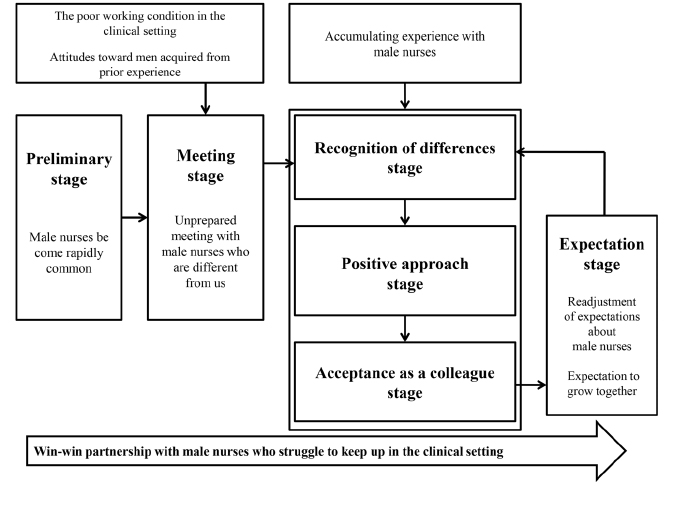J Korean Acad Nurs Adm.
2018 Dec;24(5):423-434. 10.11111/jkana.2018.24.5.423.
Win-Win Partnership in the Clinical Setting: Female Nurses' Adaptive Experience to Male Nurses
- Affiliations
-
- 1Department of Nursing, Inha University, Incheon, Korea. eunjinlee@inha.ac.kr
- KMID: 2431203
- DOI: http://doi.org/10.11111/jkana.2018.24.5.423
Abstract
- PURPOSE
The present study was done to provide understanding of how female nurses adapt to male nurses and to derive an entity concept that explains the experience process for female nurses.
METHODS
Data were collected through in-depth interviews with 16 female nurses who had work experience with male nurses. Collected data were analyzed using the grounded theory methodology of Strauss and Corbin.
RESULTS
The core category found in the adjustment experience of female nurses to male nurses was "win-win partnership with male nurses who struggle to keep up in the clinical setting". The central phenomenon was "unprepared meeting with male nurses who are different from us". The action/interaction strategies the participants used were "recognition of differences,", "positive approach," and "acceptance as a colleague."
CONCLUSION
The results showed that female nurses tried to have a win-win partnership with male nurses by using several strategies. This result broadened the range of understanding of female nurses' adjustment to male nurses and provides new information on their adaptation to practical work.
MeSH Terms
Figure
Reference
-
1. Kong BH. A philosophical inquiry on the moral horizon of care in nursing. Korean Feminist Philosophy. 2002; 2:43–69.2. Kim H, Lee JS. Turnover experience of male nurses. Journal of Korean Academy of Nursing. 2017; 47(1):25–38. DOI: 10.4040/jkan.2017.47.1.25.
Article3. Korean Nurses Association. Male nursing students 10,000 people ages [Internet]. The Korean Nurse. Vol. 258. Seoul: Korean Nurses Association;2014. cited March 3, 2018. Available from: http://webzine.koreanurse.or.kr/Webzine2014/file/webzine_258.pdf.4. Lee JH. Male nursing students 10,000 people ages: What things nursing should prepare [Internet]. The Korean Nurse. Vol. 261. Seoul: Korean Nurses Association;2016. cited April 4, 2018. Available from: http://webzine.koreanurse.or.kr/Webzine2014/file/webzine_261.pdf.5. Mackintosh C. A historical study of men in nursing. Journal of Advanced Nursing. 1997; 26(2):232–236. DOI: 10.1046/j.1365-2648.1997.1997026232.x.
Article6. Dyck JM, Oliffe J, Phinney A, Garrett B. Nursing instructors' and male nursing students'perceptions of undergraduate, classroom nursing education. Nurse Education Today. 2009; 29(6):649–653. DOI: 10.1016/j.nedt.2009.02.003.7. Ahn KH, Seo JM, Hwang SK. Content analysis of male hospital nurses' experiences. Korean Journal of Adult Nursing. 2009; 21(6):652–665.8. Lee MY, Seo EK, Park HJ, Oh JW. Health and non-health majors' perception of male nurses: Comparison focusing on previous contact experience. Journal of Learner-Centered Curriculum and Instruction. 2017; 17(13):721–739. DOI: 10.22251/jlcci.2017.17.13.721.
Article9. Kim MJ, Park SA. Experiences of hospital nurses' turnover: Determinants of factors affecting turnover intention. Journal of Military Nursing Research. 2010; 28(1):56–69.10. Strauss AL, Corbin JM. Basics of qualitative research: Techniques and procedures for developing grounded theory. 2nd ed. Thousand Oaks: Sage Publications;1998.11. Guba EG, Lincoln YS. Effective evaluation: Improving the usefulness of evaluation results through responsive and naturalistic approaches. San Francisco: Jossey-Bass Publishers;1981.12. Andrews HA, Roy C. The Roy adaptation model: The definitive statement. New York: Appleton-Century-Crofts;1991.13. Cheong HY, Yun SH. Process of overcoming turnover intention in career nurses. Journal of Korean Academy of Nursing Administration. 2013; 19(3):414–426. DOI: 10.11111/jkana.2013.19.3.414.
Article14. Cho YS, Sohn SK, Han MY, Kim MS, Bang BK, Lee KM. Nurses' lived experience of preceptorship for newly graduated nurses in hospital. Journal of East-West Nursing Research. 2014; 20(1):37–47. DOI: 10.14370/jewnr.2014.20.1.37.
Article15. Son HM, Koh M, Kim C, Moon J. The clinical experiences of adaptation as a new nursing staff. Journal of Korean Academy of Nursing. 2001; 31(6):988–997.
Article16. Bartfay WJ, Bartfay E, Clow KA, Wu T. Attitudes and Perceptions towards Men in Nursing Education. Internet J Allied Health Sci Pract. 2010; 8(2):1–7.17. Kim BH, Chung BY, Kim JK, Lee AY, Hwang SY, Cho JA, et al. Current situation and the forecast of the supply and demand of the nursing workforce in Korea. Korean Journal of Adult Nursing. 2013; 25(6):701–711. DOI: 10.7475/kjan.2012.24.6.701.
Article18. Chen SH, Yu H-Y, Hsu H-Y, Lin F-C, Lou J-H. Organizational support, organizational identification and organizational citizenship behaviour among male nurses. Journal of Nursing Management. 2013; 21(8):1072–1082. DOI: 10.1111/j.1365-2834.2012.01449.x.19. Kim SL. The meaning of nursing through healing-care poetics view. Philosophy of Medicine. 2012; 14:37–70.20. Choi SC, Woo JM, Park WS, Kim SA. Work-family conflict and job satisfaction of two-income family. Korean Journal of Occupational and Environmental Medicine. 2009; 21(1):10–17.
Article21. Alfredsdottir H, Bjornsdottir K. Nursing and patient safety in the operating room. Journal of Advanced Nursing. 2008; 61(1):29–37. DOI: 10.1111/j.1365-2648.2007.04462.x.
Article22. Davenport DL, Henderson WG, Mosca CL, Khuri SF, Mentzer RM Jr. Risk-adjusted morbidity in teaching hospitals correlates with reported levels of communication and collaboration on surgical teams but not with scale measures of teamwork climate, safety climate, or working conditions. Journal of the American College of Surgeons. 2007; 205(6):778–784. DOI: 10.1016/j.jamcollsurg.2007.07.039.
Article23. Suh YO, Lee KW. Female peer nurse's experiences working with the male nurses. Journal of East-West Nursing Research. 2017; 23(1):33–44. DOI: 10.14370/jewnr.2017.23.1.33.
Article24. Parse RR. Man-living-health: A theory of nursing. New York: Wiley;1981.25. Choi SJ. Male students' lived experience in the female-dominant nursing college. Journal of Qualitative Research. 2003; 4(1):52–62.26. Kim MY. An exploratory study of masculinity in nursing. Journal of Korean Clinical Nursing Research. 2009; 15(2):37–46.27. Ahn SY. Gender and political space with a focus on the rhetoric of female politicians. Journal of Korean Women's Studies. 2014; 30(2):203–231.
- Full Text Links
- Actions
-
Cited
- CITED
-
- Close
- Share
- Similar articles
-
- Levels of Partnership between Nurses and Parents of Hospitalized Children and the Quality of Pediatric Nursing Care as Perceived by Nurses
- Nursing Professionalism, Self-Efficacy and Nurse Parent Partnership in Pediatric Nurses
- Relationship among Sense of Humor, Self-esteem, and Performance in Nurses
- Clinical Nurses' lived Experience of Interpersonal Relations in the Ward Setting of the hospital
- Importance of and Influencing Factors on Nurses' Caring Behaviors for Elders with Dementia


